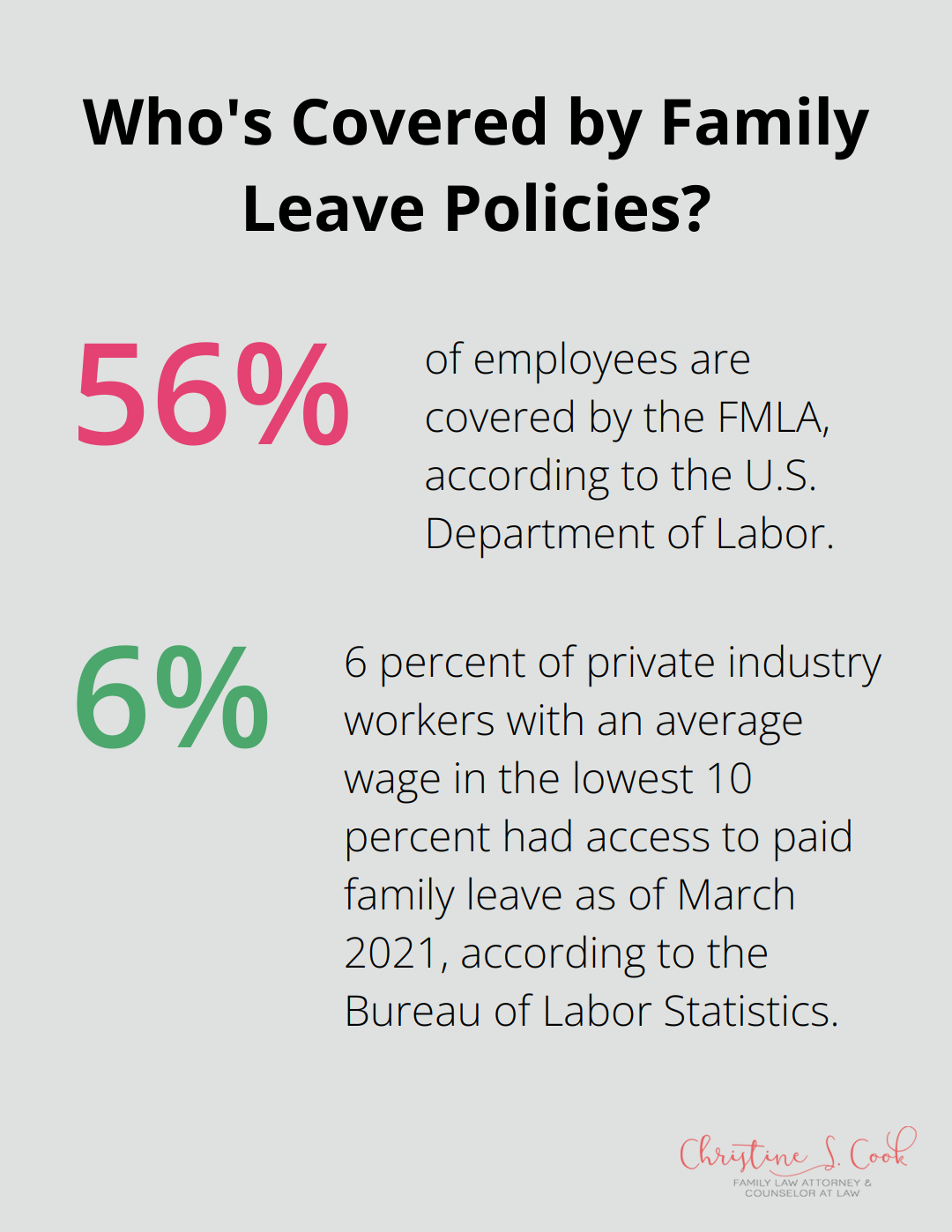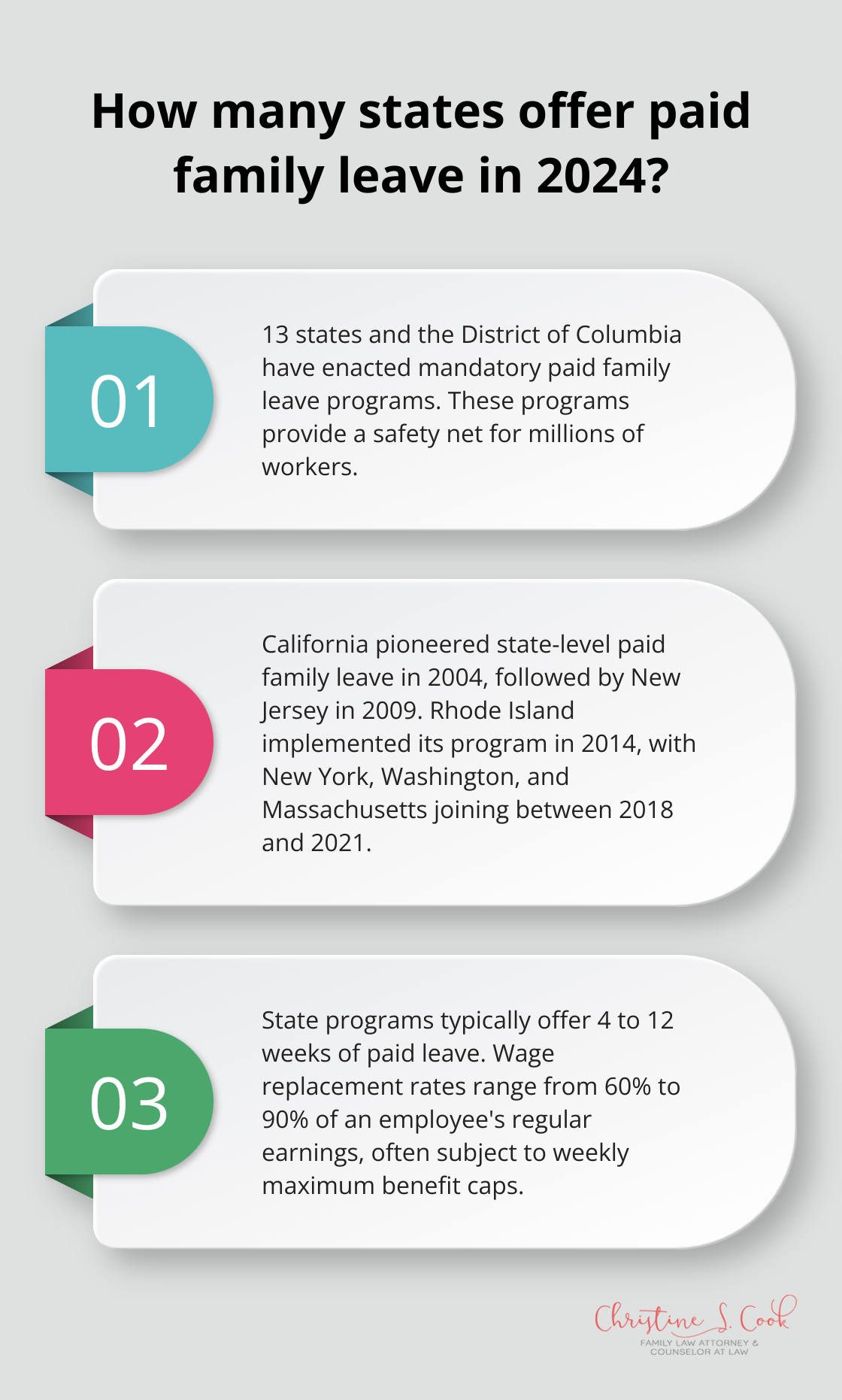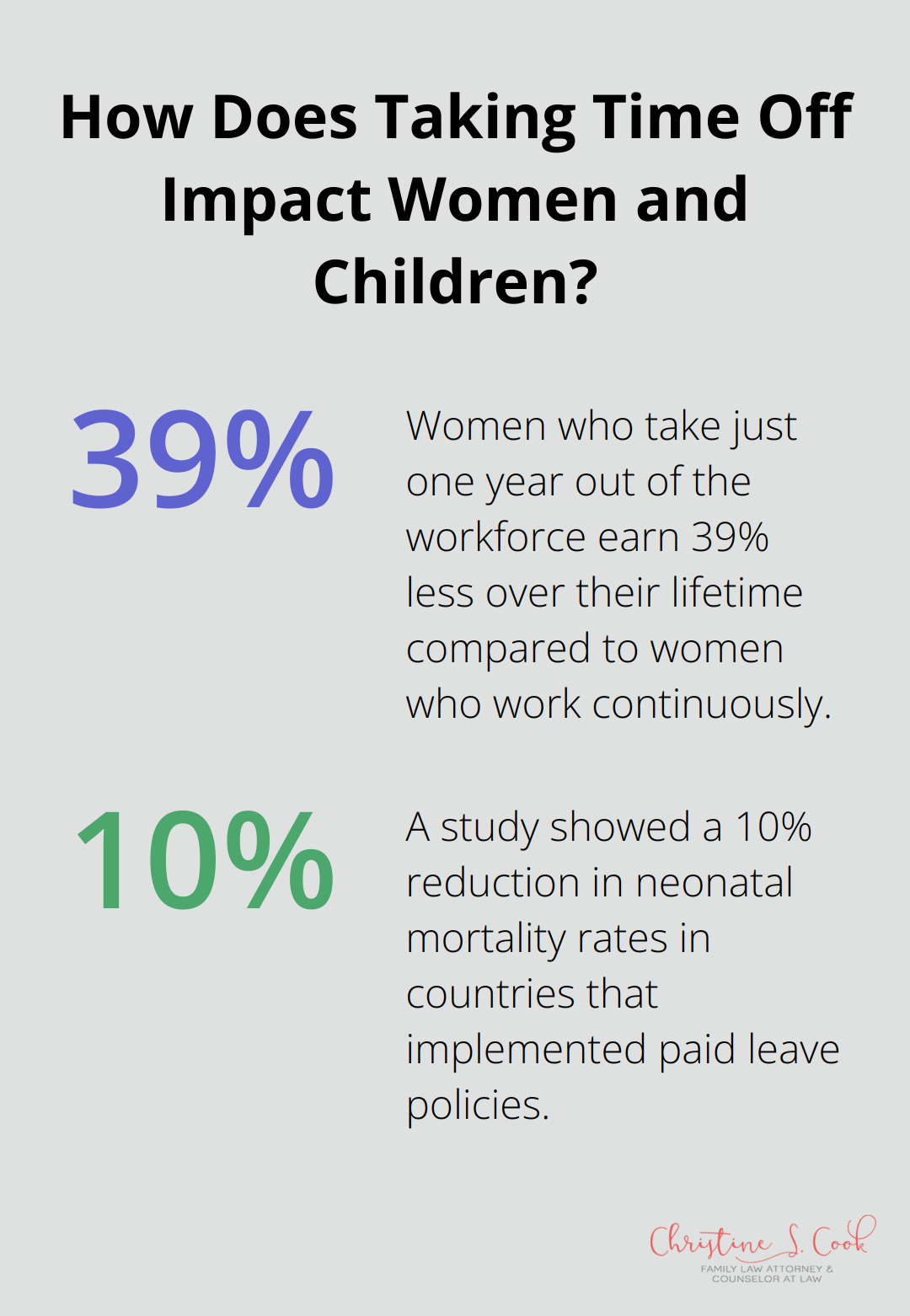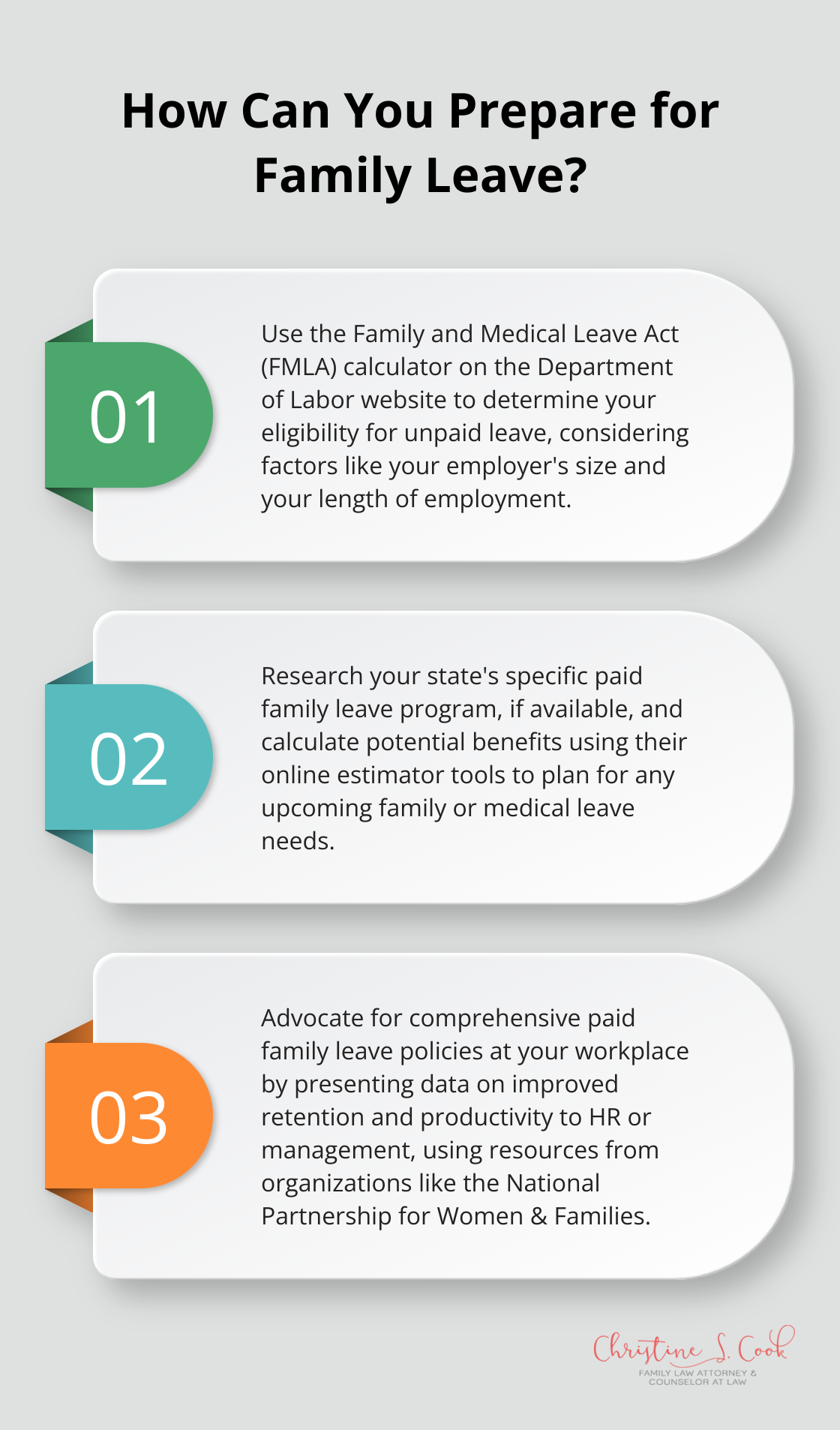At Christine Sue Cook, LLC, we often field questions about family leave policies. Many workers wonder: Is paid family leave a federal law?
The answer isn’t straightforward, as the United States lacks a comprehensive federal paid family leave program. This blog post will explore the current landscape of family leave laws, including federal and state-level policies, and their impact on American families.
The primary federal law addressing family leave is The Family and Medical Leave Act (FMLA), enacted in 1993. This law provides eligible employees with up to 12 weeks of unpaid, job-protected leave per year for specific family and medical reasons. These reasons include the birth or adoption of a child, caring for a spouse, child, or parent with a serious health condition, or the employee’s own serious health condition.

However, the FMLA has significant limitations. It only applies to employers with 50 or more employees, and workers must have been employed for at least 12 months and worked at least 1,250 hours in the past year to be eligible. According to the U.S. Department of Labor, these restrictions mean that only about 56% of employees are covered by the FMLA.
While there is no federal paid family leave program, recent proposals aim to address this gap. The FAMILY Act, introduced in Congress, proposes a national paid family and medical leave program funded through payroll contributions from both employees and employers. This would provide up to 12 weeks of partial income for family and medical leave reasons.
Another notable development is the Federal Employee Paid Leave Act (FEPLA), enacted in December 2019. This law provides 12 weeks of paid parental leave to eligible federal employees, marking a significant step forward in federal family leave policy.
The lack of a comprehensive federal paid family leave program has significant consequences for American workers. According to the Bureau of Labor Statistics, only 6 percent of private industry workers with an average wage in the lowest 10 percent had access to paid family leave as of March 2021. This gap in coverage often forces employees to use various forms of leave or face financial hardship when they need extended time off for family or medical reasons.
It’s important to understand your rights under both federal and state laws. While federal protections are limited, some states have implemented their own paid family leave programs, which may provide additional benefits. Stay informed about both federal proposals and state-level initiatives that could affect your family law options.
As we explore the landscape of paid family leave in the United States, it’s clear that the federal government has yet to implement a comprehensive program. This lack of federal action has led many states to take matters into their own hands. In the next section, we’ll examine the state-level paid family leave programs that have emerged to fill this gap.
In response to the lack of federal paid family leave, several states have implemented their own programs. As of 2024, thirteen states and the District of Columbia have enacted mandatory paid family leave systems, providing a safety net for millions of workers.
California led the charge in 2004, followed by New Jersey in 2009 and Rhode Island in 2014. More recently, New York, Washington, and Massachusetts joined the ranks, with their programs taking effect between 2018 and 2021.

These state programs typically offer 4 to 12 weeks of paid leave, with wage replacement rates ranging from 60% to 90% of an employee’s regular earnings (often subject to weekly maximum benefit caps). For instance, California’s program provides up to 8 weeks of leave with a 60-70% wage replacement rate, while New York offers 12 weeks at 67% of the employee’s average weekly wage.
Most state programs receive funding through payroll taxes, with contributions coming from employees, employers, or both. Eligibility requirements vary but generally include minimum earnings or hours worked within a specified period.
Washington state, for example, requires employees to have worked at least 820 hours in the qualifying period to receive benefits. This approach ensures that both full-time and part-time workers can access paid leave benefits, addressing a gap often present in employer-provided leave policies.
A key feature of many state programs is their comprehensive coverage. Unlike the federal FMLA (which applies only to companies with 50 or more employees), state paid leave laws often cover a broader range of workers, including those in smaller businesses.
Moreover, these programs typically encompass a wider definition of family, allowing leave for care of extended family members or chosen family. New Jersey’s program, for instance, includes care for siblings, grandparents, and parents-in-law, reflecting the diverse caregiving responsibilities many workers face.
State paid family leave programs can significantly impact families’ ability to balance work and caregiving responsibilities. They provide a financial lifeline during times of need, whether it’s bonding with a new child or caring for a seriously ill family member.
As more states consider implementing paid family leave programs, workers must stay informed about their rights and benefits. The landscape of family leave continues to evolve, and understanding these state-level programs can make a substantial difference in navigating work-life balance and family care needs. The next section will explore the impact of the current lack of federal paid family leave on American families and the broader economy.
The absence of a federal paid family leave program in the United States creates significant financial challenges for families. Today in the United States, workers are not guaranteed a single paid day off by federal law, and many aren’t even entitled to unpaid time off. This financial pressure often forces workers to return to work prematurely, potentially compromising their health or the well-being of their loved ones.

New parents without access to paid leave might return to work just weeks after childbirth, impacting both their recovery and early bonding with their child. Workers caring for ill family members may struggle to balance work and caregiving responsibilities, often at the expense of their own health and financial stability.
The lack of federal paid leave disproportionately affects women, who more frequently take on caregiving responsibilities. Women do one-and-a-half times as much caregiving work as men.
This gender disparity has long-term implications for women’s career advancement and earning potential. Women who leave the workforce for caregiving often face challenges re-entering at the same level, contributing to the persistent gender wage gap. The Institute for Women’s Policy Research estimates that women who take just one year out of the workforce earn 39% less over their lifetime compared to women who work continuously.
The absence of paid family leave also has significant health implications. A study published in the Journal of Health Economics found that paid parental leave correlates with reduced infant mortality rates and improved maternal health outcomes. Specifically, the study showed a 10% reduction in neonatal mortality rates in countries that implemented paid leave policies.
For families caring for ill members, the stress of balancing work and caregiving without financial support can lead to burnout and health issues for the caregiver. This not only affects the quality of care provided but also increases healthcare costs in the long run.
The lack of federal paid leave has broader economic implications. Businesses face increased turnover costs when employees leave due to caregiving responsibilities. A study by the Center for Economic and Policy Research found that companies in states with paid leave programs reported improved employee retention and productivity.
Moreover, the absence of paid leave can lead to increased reliance on public assistance programs. Families without financial support during periods of caregiving may turn to government aid to make ends meet, potentially increasing the burden on taxpayers.
Without federal paid leave, workplace culture often fails to support employees’ work-life balance. This can lead to increased stress, decreased job satisfaction, and lower overall employee well-being. Companies that offer paid leave (even in the absence of federal mandates) often report higher employee morale and loyalty.
The question “Is paid family leave a federal law?” has a complex answer. The United States lacks a comprehensive federal paid family leave program, but some protections exist through the Family and Medical Leave Act (FMLA). These protections are limited and do not provide paid leave for most workers.

Several states have implemented their own paid family leave programs, which provide a model for potential future federal legislation. These state-level initiatives demonstrate the feasibility and benefits of paid leave policies, from improved health outcomes to increased employee retention and productivity. The push for a federal paid family leave program continues, with growing awareness of its importance and bipartisan support for some form of paid leave.
At Christine Sue Cook, LLC, we help our clients navigate the complexities of family law, including issues related to family leave. Our experienced team provides guidance on your rights under current laws and helps you explore options for balancing work and family responsibilities. We encourage you to stay informed about your rights and options as the landscape of family leave laws continues to evolve.
